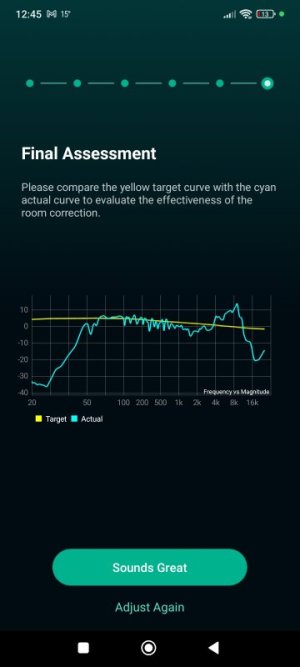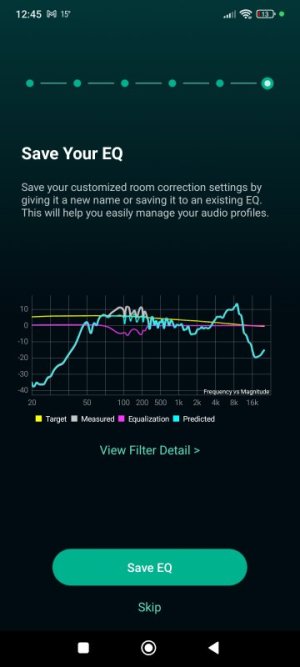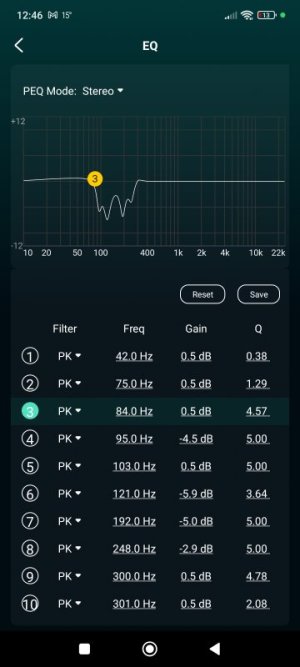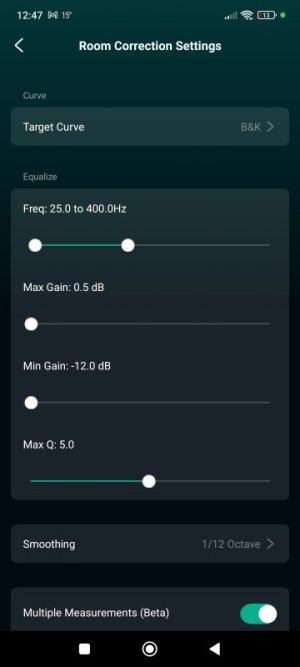While I agree with the main points of your post (i.e. close to wall placement has drawbacks and that treating the wall with absorption can be beneficial), I'm still quite convinced this type of placement is a very good option for most people.
Let me elaborate my position.
First, it is important to understand that the early reflection from the loudspeaker to the wall behind it will cause an interference pattern with the direct sound of the loudspeaker - this is a fact regardless of the distance between the loudspeaker and the wall - i.e. close to wall placement will
not eliminate the interference.
What does change as we change the distance is:
- Delay between the direct sound and the early reflection,
- Frequency where the interference pattern starts, and
- How deep the nulls / how high the peaks are in the interference pattern.
We call this interference SBIR (Speaker Boundary Interference Response), and it applies to all boundaries (walls, ceiling, floor) around a loudspeaker, not just the wall behind it.
Here's an illustration
from the Genelec article I linked to previously:
The main principle is that as we move the loudspeaker
further from a wall the first dip in the response
will move to a lower frequency and become deeper / more severe, and as we move it
closer to a wall the first dip in the response
will move to a higher frequency and become shallower / less severe.
Now, let's try to be pragmatic and calculate the first few SBIR null/peak frequencies for various distances from the wall:
View attachment 19606
The top row shows how close the
front face of the loudspeaker needs to be to the wall to push the first SBIR null above 20kHz (i.e. the commonly accepted human hearing limit). As you can see, the distance to achieve this is only 4mm, meaning that the loudspeaker body would need to be
in the wall.
Note that this is why soffit mounting of loudspeakers (i.e. installation where the loudspeaker front face is flush with the wall) is considered the ideal and is used widely in professional recording studios - when the loudspeaker front face is flush with the wall the SBIR frequencies will go to so high a frequency they will effectively be out of the human audible range.
In other words, no box speaker can go that close to the wall behind it in most practical scenarios because the typical bookshelf speaker box depth is usually 30-50cm. Here I assume most people won't be willing to do construction work to place their speakers.
If we also assume additional ~5cm distance for back port to work properly, the realistic distance for many people will be 35-55cm from front face of the loudspeaker to the wall behind it. As you can see from the table will put the first SBIR null/dip between about 150-300Hz.
The table above should also illustrate that by pushing the loudspeaker away from the wall we push the SBIR interference to a lower frequency and spread it over a wider frequency range.
As you can see, having the loudspeaker more than about 0,6m from the wall behind it will put the first/main SBIR null/dip right in the upper bass (80-150Hz), where a lot of the energy is in many mixes. This dip will also be more severe (i.e. deeper) than the one caused by closer to wall placement.
This is why placing loudspeakers such that their front face is >0,6m from the wall behind is usually not recommended.
This is also why for full-range loudspeakers (i.e. loudspeakers used without subwoofers) it is recommended to place them close to the wall behind them.
Now notice that for speaker placement >1,1m from the wall the first SBIR dip gets below ~80Hz.
If you have your loudspeakers high-passed at 80Hz (e.g. because you have a subwoofer with 80Hz crossover) then in this case the first SBIR dip goes out of the operating range of the loudspeaker - which is great! While this doesn't solve the subsequent SBIR peaks and dips, the 1st dip is the deepest and the most audibly offending.
This is why speaker placement >1,1m from the wall is recommended for systems crossed to a sub at 80Hz. In this case the sub is recommended to be placed as close as possible to a wall to keep the subwoover SBIR null/dip above 80Hz. In this way the main SBIR nulls of both the loudspeakers and the subwoofer are outside of their operating ranges - making this the second-best placement option (i.e. behind soffit mounting loudspeakers).
However, the problem with this is that having loudspeakers >1,1m into the room is quite intrusive and not really an option for most people for practical reasons.
Note that pushing the loudspeakers close to the wall behind is still an acceptable (but slightly worse) alternative, for the same reasons as explained above. It may be an acceptable compromise to many for practical reasons.
As we can see, neither placement option 1 (soffit mounting loudspeakers) nor option 2 (loudspeakers >1,1m into the room + a well integrated subwoofer) may be practical for most people.
On the other hand, placement close to the wall behind is a reasonable compromise that works similarly well with and without subwoofers, and is not physically intrusive.
Now let me come back to your suggestion to add acoustic treatment to the back wall. The intention here would to absorb the early reflection from the back of the loudspeaker and thereby avoid the SBIR interference altogether.
First, let's see how the back reflection spectrum actually looks like compared to the direct sound for two different box-type front-firing loudspeakers (blue is the direct sound, green is the back reflection, solid lines belong to speaker 1, and dashed lines belong to speaker 2;
source):
View attachment 19607
Since most commercial loudspeaker designs are not omnidirectional, the spectrum of the back reflection will be decreasing with frequency - which is what we see in this plot too for both speakers. The slope of this decrease depends on loudspeaker directivity - wide directivity designs (speaker 1) will decrease slower, while narrow directivity designs (speaker 2) will decrease faster with frequency.
We can see that in both speakers by about 1000Hz the back reflection is already attenuated by about -10dB compared to the direct sound. This explains why we see that SBIR interference becomes less severe as it is pushed up in frequency - the back reflection has less energy and therefore less influence on the total sound heard at the main listening position.
This also means that if we are to try and absorb the back reflection we need absorbers that have high absorption below 1000Hz, and especially high absorption at the frequency of the first / main SBIR null.
On the other hand, typical porous absorbers work well at high frequencies but poorly at low frequencies. So if we wish to have any theoretical chance of minimizing the SBIR dip via acoustic treatment we need to push the loudspeaker close to the wall behind so that the SBIR null goes as high as possible in frequency.
Now let's looks at the sound absorption coefficient of some commonly used acoustic panels (
source):
As you can see, even 10cm thick acoustic foam is not very efficient <300Hz, and such thickness won't even fit behind the loudspeaker if we pushed it close enough to the wall to put the SBIR dip >200Hz.
Mineral/glass wool panels are much more efficient at these frequencies, but again the thickness required to be efficient <300Hz make them difficult to place behind a loudspeaker when placed close to the wall behind.
If you push the loudspeaker further from the wall you will be able to place thicker absorption panels, but then the SBIR dip will move lower in frequency and unfortunately it will again end up below the panel operating range.

While perhaps not impossible, this should illustrate that absorbing the back reflection will be challenging at the very least.
Not to mention that most people probably don't want to have 10cm thick acoustic panels in their living rooms...
Having all of the above in mind, I stand behind my recommendation to place loudspeakers close to the wall behind them. It is IMHO a reasonable compromise that sounds quite good (even if not the best), while not being very intrusive in residential spaces.
At this point it is perhaps worth to mention cardioid bass loudspeakers. These are designed to minimize the level of the back reflection in the 100-300Hz range (
example), and thereby decrease SBIR null/dip severity for close to wall placement. They are an amazing solution to these issues for residential spaces, but are unfortunately still quite expensive.
So to summarize, my placement recommendations are as follows:
- The generic recommendation is to put loudspeakers close to the wall behind.
- It is simple, sounds good and is non-physical-intrusive, but also not ideal.
- For those that don't want compromises the following "better" options exists (from "best" to "worst"):
- Soffit mounting loudspeakers
- Cardioid bass loudspeaker placed close to a wall
- Front-firing loudspeakers <1,1m away from walls and integrated to subwoofer(s) crossed at 80Hz
- Front-firing loudspeakers close to the wall behind and try to absorb the SBIR dip
Hope this is useful!
Again I can agree only partially.
DSP will not solve everything, this I agree with completely, and I also agree that people shouldn't expect that using DSP/RC will magically solve all acoustic problems - regardless of how it is sometimes marketed.
But even in case of less-than-ideal placement DSP can solve some very audible issues and thereby improve the sound significantly. Note that we're much more sensitive to peaks than dips, so addressing peaks has huge value and DSP is pretty well-suited for that task. I disagree that this is a waste of time.
However a big issue with automated room correction / DSP is that it can also try to correct issues that simply aren't there and thereby can also make the sound significantly worse. Unfortunately we're still at a point where significant competence is needed from the end-user to tune the settings to make it work well. This is definitely why it can
feel like a waste of time.
Finally, I fully agree that optimizing placement/layout and then carefully applying DSP is the optimal solution. This is perhaps great news for us audio enthusiasts, but I'm sure it is really discouraging for casual users who probably just want audio systems that are easy to setup and use and just sound good.








